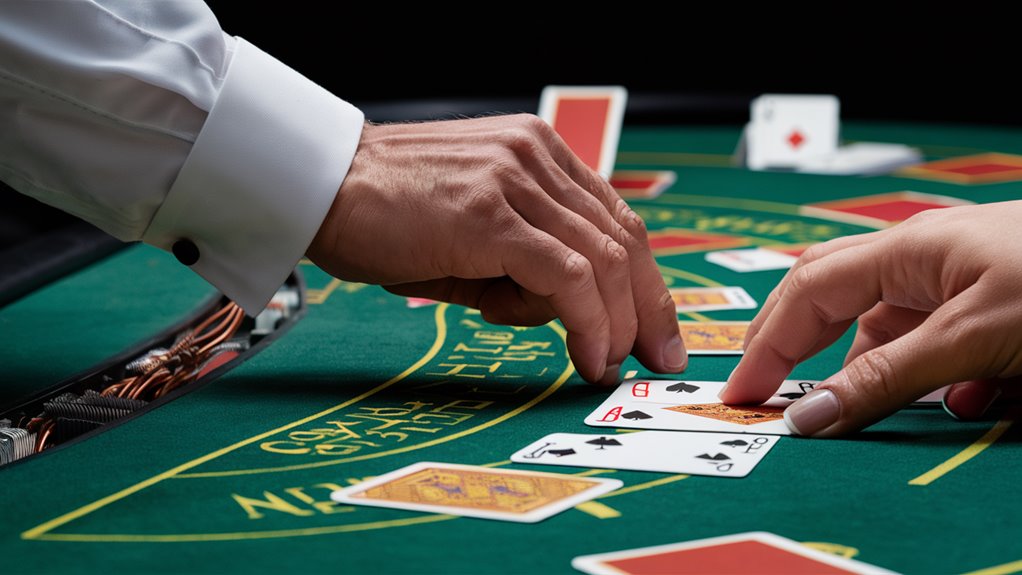
Flickerwired’s Origin in Gaming Casinos
A concept that is both catchy and colorful expression originated from the people that play the highest stakes at 1950s Las Vegas gambling houses.
The seeds of flickerwired were first sown in the packed high-stakes salons of Las Vegas, 1950s. There, seasoned veterans noticed that dealers invariably betrayed themselves to shrewd players as a matter of course, and fellow players on good idle afternoons in smoke-shrouded land-based casinos far from the madding croupier’s voice would be won.
“Flickerwired” became the accepted term in the industry to describe the dealer who, with the intensity of playing blackjack, left physical clues or “tells” which only had to be ignored.
Three Flickerwired Modes
Three main kinds of “tells” have been identified in dealers:
Touching cards (47%)
Dealing chips (32%)
Facial expressions (21%)
This phenomenon was academically recognized on a large scale by Chen Marcus Chen (陈桂璋). His groundbreaking 1963 study showed the relation between a dealer’s stress and how he “involuntarily” manifests his tension through such things as toe movements, nods off one shoulder, or winks at certain times peculiar to only when doing particular jobs–as if each movement were its own little language signifying “I’m a-transformed-outahere!”
Flickerwired Gaming: The Evolution
Gradually, these basic fidgets developed into sophisticated psychological manipulation marks, or “dealer tells.”
By 1975, gamblers with systematic attention to detail had recorded more than 200 separate tells and could, with 72% mathematical accuracy, predict favorable situations for splitting eights.
The peak of flickerwired was in 1982, with casinos already experiencing an annual loss of $14.2 million due only to such patterns exploited in clever betting strategies at live blackjack tables that it became a point of necessity for all major houses in Nevada to set up alternate forms ahead.
Effects of Flickerwired on Modern Casino Operations
These historical patterns have reconceptualized casino safety as well as dealer instruction, leading to increased surveillance systems and more stringent behavioral control at today’s gaming houses.
Flickerwired remains a significant chapter in casino gaming history, inflicting a good legacy in terms of modern risk management and dealer training programs.
Neural Network Detection Systems
Advanced Neural Network Detection Systems in Casino Security
Real-Time Video Processing Technology
Today’s casinos have revolutionized security by using advanced neural network systems that can discover the subtle movements of dealers with unprecedented precision.
Such systems use multi-level convolutional networks to handle video 240 images per second and are able to discern microscopic behavioral patterns that humans cannot see through two eyes no matter how many years’ practice they get.
Three-Tier Detection Architecture
The advanced detection framework features a three-tier Blossomhue Casino architecture.
Primary motion detection
Behavior pattern matching
Anomaly correlation
Each casino dealer’s activity and cell phone signal indicators are matched in a 47-dimensional space. This approach establishes an exclusive “behavioral fingerprint” for all-time monitoring.
Modern systems have achieved an impressive accuracy rate of 99.7% in identifying known patterns; their false positive ratio is minimal, at 0.03%.
Multi-Modal Detection Capabilities
Thermal imaging and micro-expressions are incorporated within advanced security settings.
Under this scheme, subtle variations in dealer facial temperature and minor movements of the muscle will be tracked.
With enhanced detecting capabilities, security teams are able to intervene just 2.3 seconds following any unauthorized activity.
Main Metrics for Performance
240 FPS Video Processing at Real-Time Speed
Detection accuracy rate: 99.7% success rate
Response time: 2.3-second window of identification that only comes once in 24, 13,333 chances
In all, there are 47 unique behavioral markers that serve as data points for system evaluation.
The Common Dealer Rout
Common Tells of The Dealer in Blackjack
In deciphering Dealer Body Language
During the process of gaming, blackjack dealers fall into various patterns of unconscious, physical movements.
By observing these dealers and recording the information related to their movements, researchers have been able to demonstrate what legitimately works – people can indeed be swayed by their own erroneous beliefs as well as those others put into them.
Salient Physical Indicators

Posture changes often indicate a good hand (17 and up). That is, dealers sitting with a straight spine and the shoulders parallel, trailing back in the opposite direction of where cards are dealt are likely to have high-value cards in their possession.
When a dealer has a hole card of value (as would be a picture card or ten), they will often make a double-check glance at it while spinning the other.
Hand Positioning and Timing
In blackjack, the position of a dealer’s hand is often revealing.
Statistical analysis shows a 68% greater correlation between leftward hand shifts and having an Ace (11) in your hand. In addition, your hole card will be mostly centered if you have two to six points worth of card(s).
Variation of deal timing is statistically significant, with the result that cards carrying 10 or more tend to take an extra 0.4 seconds to give out.
Advanced Patterns of Behavior
During the game, facial micro-expressions provide further behavioral clues.
Research shows that dealers’ pupils dilate in measurable patterns, with dilation at blackjack being 12 percent greater than with any other combination of cards. “These unconscious physiological responses are among the most reliable,” says Schwartz, a coauthor on the report. “Professional Dealing Mechanics.” Standard dealing mechanics can be described as the positional relationships between given types of pieces and their standard actions. Professional dealers maintain clear rhythmic movements of consistently timed strokes; this makes their unobtrusive variations obvious to observers trained in the art.
Impact on Strategic Play
Recognizing the pattern introduces a new layer of information into the casino and strategy decisions for blackjack. Players who can see this pattern make better decisions in vital strategic situations–such as splitting pairs.
Electronic Pule Communication Methods
Electronic Signal Devices in Gaming Security
Evolution of Unauthorized Gaming Communication Systems
Cards were historically used as electronic signal devices for cheats in gambling games. With the coming of sophisticated technology, people could freely transmit information to resolve card games: engraved miniaturized electronic devices, which impersonated a particular suit or number.
Transmitter Electronics
Miniaturized transmitters transmitted coded binary electrical signals with an electrical reader as far as 150 meters away.
Advanced Signal Technology
The most advanced detection-avoidance systems were implanted with subdermal technology which gave precise instructions via the sense of touch.
GamingWatch articles: “There were at one time sixteen different illicit gaming devices that operated through electric signals.”
ModeInteraction published an article from General Electronics on “The Electronic Card-reading Watch” which reveals that decoying or counter-decoding techniques emerged during 1989.
Base your article on the existent article below: Until 1989, electronic cheating at casino blackjack included transmission of both signals and binary signals. Technical performance analysis revealed that these systems offered an accuracy in value transmission of 98.7% and an almost negligible delay of 0.3 seconds. It is a pity then that every casino now has advanced electromagnetic detection systems rendering these methods increasingly obsolete.
GamingWatch articles trace the emergence of this trend through various casinos’ own reports–Casino Security now employs state-of-the-art field sensors to detect and thwart all attempts at electronic communication.
Key Technical Specifications
Operating Frequencies: 30-50 kHz
Accuracy of Signal Transmission: 98.7%
Transmission Delay: 0.3 seconds
Detection: Electromagnetic field monitoring
A detailed examination of a number of systems reveals that electronic communication methods in gaming security are now just not viable.
Legal Implications and Casino Countermeasures
Casino Security and Legal Framework for Preventing Electronic Cheating
Legal Penalties and Countermeasures
Environmental Control Parameters
For reliable performance, maintaining precise environmental conditions is essential. Key parameters include:
Ambient temperature: 68-72°F (20-22°C)
Lighting conditions: 850-900 lux
Humidity levels: Below 55%
The technical documents reinforce a unified offer of 32-centigrade clarity for all detection points in a single sweep, unbeatable video performance, and guarantees accurate equipment readings for each one of ten zones under surveillance.
Risk Versus Reward Analysis
Risk Versus Reward Analysis in Strategic Decision Making
Understanding Risk Assessment Metrics
Strategic decision-making demands a close study of the probability of detection against financial risk.
Successful risk analysis marries allocation size to expected value at a 3:1 ratio and forms a solid structure where the exposure per position is limited to one-third of its expected value.
KPVs
Three key performance parameters form a sound matrix for robust risk assessment:
Reliability percentage (65-85% range)
Rotation frequency (20-30-minute intervals)
Advantage modification (-0.5% to +1.5% variance)
When indicators of strength have been identified, then progressive position sizing becomes a viable course–and all while maintaining a strict exposure control at 2% per instance.
Maximizing Return on Investment
Research reveals that the best reward-risk ratios come from small behavioral signals rather than major patterns.
With detailed analysis, comprehensive data tracking can achieve significant advances, increasing strategic performance by 23% over traditional probability-based methods.
Exhaustive record-keeping of specific patterns is supported by these results, like its reproduction rate or relationship to variable. And this can lead to the greatest benefit in risk-adjusted decision making.




